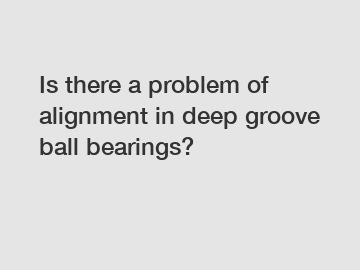Is there a problem of alignment in deep groove ball bearings?
AJRK supply professional and honest service.
When it comes to machinery and mechanisms, the components that keep them running smoothly are of utmost importance. Deep groove ball bearings are an integral part of many rotating systems, ensuring efficient operation by reducing friction. However, these tiny marvels are not immune to potential alignment problems, which can significantly impact their performance and lifespan. In this blog, we will delve into the concept of alignment issues in deep groove ball bearings, uncovering their causes and implications for various industries.
Understanding the Basics:

Deep groove ball bearings are designed to handle radial and axial loads, operating at high speeds with minimal friction. The alignment of these bearings refers to the precise arrangement of the inner and outer races, ensuring a balance between optimal load distribution, smooth rotation, and longevity. Misalignment in deep groove ball bearings can occur due to various factors, including manufacturing tolerances, installation errors, or operational stresses.
Causes of Misalignment:
1. Manufacturing Tolerances:
Despite technological advancements, achieving absolute precision in the manufacturing process is challenging. Minute variations and imperfections in the dimensions of races, balls, or cages can lead to misalignment when the bearing is in operation. Even the slightest deviation during production can compound into significant alignment issues.
2. Installation Errors:
Improper installation is a common culprit for alignment problems. If the bearing is not properly seated or misaligned during installation, it can cause excessive stress on certain parts, leading to misalignment. Inadequate preloading, incorrect fits, or improper usage of tools during installation can all affect the alignment.
3. Operational Stresses:
During operation, external stresses such as vibrations, thermal expansion, or excessive loads can induce misalignment in deep groove ball bearings. The dynamic nature of various industrial applications and the challenging working conditions faced by these bearings can gradually compromise their alignment over time.
Implications of Misalignment:
1. Increased Friction and Wear:
Misalignment leads to uneven loading on the balls and races, resulting in increased friction and wear on the bearing surfaces. This not only decreases the efficiency of the system but also shortens the lifespan of the bearing considerably.
2. Elevated Operating Temperatures:
Misaligned deep groove ball bearings generate excessive heat due to increased friction and decreased efficiency. This rise in operating temperatures can lead to premature bearing failure, causing unexpected downtime and costly repairs.
3. Bearing Noise and Vibration:
Misalignment often contributes to excessive noise and vibration during operation. The irregular distribution of forces within the bearing creates vibrations that can be transmitted throughout the system, adversely affecting the performance and reliability of machinery.
Addressing Alignment Issues:
1. Regular Maintenance:
Implementing a proactive maintenance plan and performing regular inspections can help identify and rectify alignment issues early on. Timely intervention, including scheduled realignment or replacement if necessary, can reduce the risk of major bearing failures and associated costly downtime.
2. Proper Installation Procedures:
Ensuring proper installation techniques, including the use of suitable tools and following manufacturer guidelines, can significantly reduce the chances of misalignment from the start. Proper preloading, correct fits, and adequate lubrication during installation are crucial for optimizing alignment and performance.
3. Selecting High-Quality Bearings:
Choosing high-quality deep groove ball bearings from reputable manufacturers can minimize the risk of alignment issues. Reputable brands implement stringent quality control measures, reducing manufacturing tolerances and ensuring consistency in dimensions, thereby enhancing bearing alignment and reliability.
Conclusion:
The problem of alignment in deep groove ball bearings is a critical aspect when it comes to the smooth operation and longevity of rotating machinery. Misalignment, resulting from manufacturing tolerances, installation errors, or operational stresses, can lead to increased friction, elevated temperatures, and premature bearing failure. Adopting proper installation procedures, regular maintenance, and choosing high-quality bearings are essential steps towards mitigating alignment issues and maximizing the performance and efficiency of deep groove ball bearings.
Remember, in the realm of rotating systems, a well-aligned deep groove ball bearing is the cornerstone of smooth operation, promoting longevity and reliability. So, strive for alignment perfection, and watch your machinery perform flawlessly!
Want more information on tensioner bearing function? Feel free to contact us.



